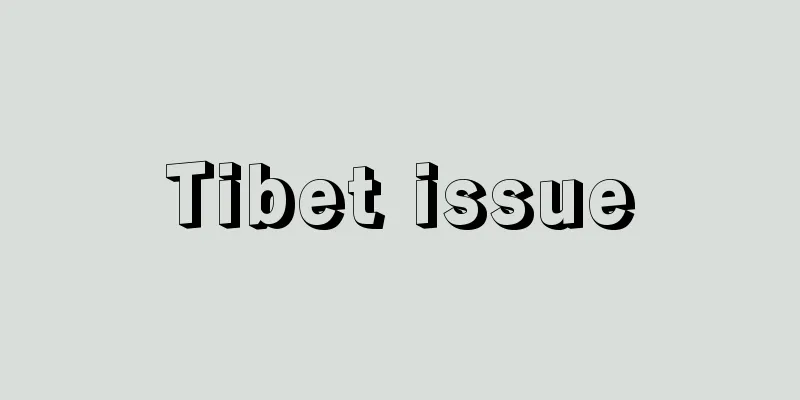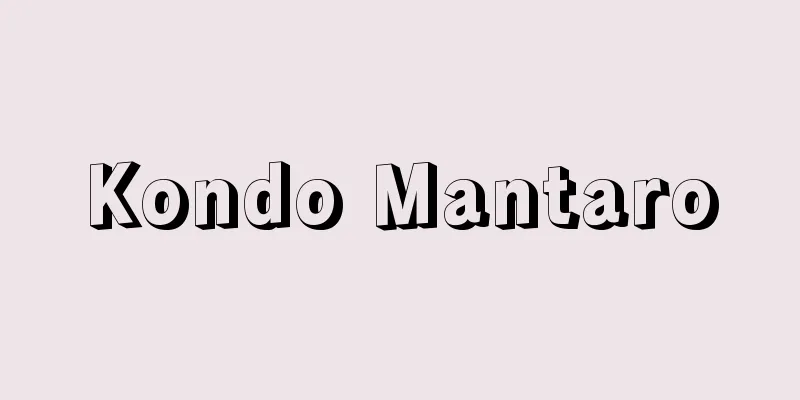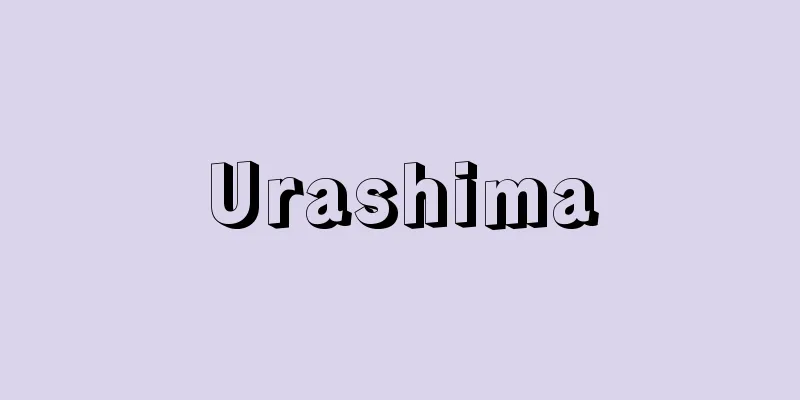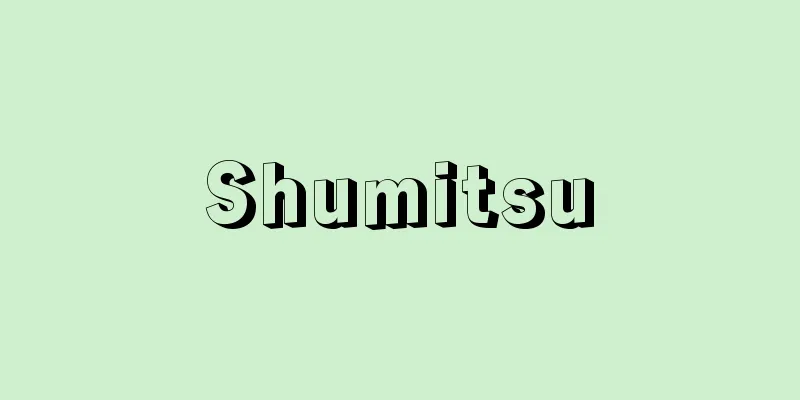Tibet issue

|
Conflicts and problems arising from Tibetans, who have a culture of unity of religion and state based on Tibetan Buddhism, seeking independence or a high degree of autonomy from China. In recent years, there have been frequent instances of self-immolation by monks who resist the authorities, and the oppression of religion and freedom in Tibet has become an international issue as a human rights problem. The religious leader, the 14th Dalai Lama, fled to India in 1959 and established a government in exile (Ganden Phodrang) in Dharamsala. There are 6.82 million Tibetans living in China, of which 2.7 million live in the Tibet Autonomous Region and the rest live in autonomous prefectures such as Qinghai, Gansu, Sichuan, and Yunnan (2010 China Population Census). [Kazuko Mori April 18, 2018] The Three "Tibets"The Tibetan issue is more complicated than those of Xinjiang Uyghur or Inner Mongolia. First, Tibet has a long history of "de facto independence," and even after the People's Republic of China was established, integration into the mainland only began after the rebellion in March 1959, and it was only after the creation of the Tibet Autonomous Region in 1965 that it was incorporated into the administrative system. Secondly, Tibet's political, religious, and cultural uniqueness, as well as its natural fortress location over 4,000 meters above sea level, make integration difficult. Also, the central authorities and Tibetans have different views on "what Tibet is." In the "Greater Tibet" concept advocated by the 14th Dalai Lama and the Tibetan government in exile, many Tibetans are scattered in the surrounding Tibet (Amdo is almost the whole of Qinghai and part of Gansu, Kham is the former western part of Xikang, now western Sichuan and northern Yunnan) surrounding U-Tsang (Central Tibet), and they consider "Greater Tibet" and "where Tibetans live" to be "Tibet." In other words, there are three Tibets. The area is twice the size of the current autonomous region. Since 1987, the 14th Dalai Lama has been calling for a "Democratic Tibet, a neutral Tibet without nuclear weapons" "in partnership with China," with this "Greater Tibet" in mind. On the other hand, the Tibet referred to by the central government is limited to the Tibet Autonomous Region. [Kazuko Mori April 18, 2018] March 1959 Tibetan UprisingAfter the Chinese People's Liberation Army invaded Tibet in 1951, the "17-Point Peace Agreement" was concluded between three Tibetan sides (the Dalai Lama's forces, the Panchen Lama's forces, and Awang Jigme Ngapoi Ngawang Jigme (1910-2009)'s forces) and the central government, which confirmed that Tibet had "returned to the great republican family" while promising that the political and religious systems in the Tibetan region at that time would not be changed. However, the situation changed dramatically from 1957, when "democratic reforms" and collectivization of agriculture and livestock began. In March 1959, Tibetan Buddhist monks and former rulers rebelled, centered in Lhasa. When the Chinese Communist authorities invited the 14th Dalai Lama to a play, Lhasa residents (some say 30,000 people) who thought that the Dalai Lama would be abducted and taken to Beijing surrounded the Nobulingka villa, shouting "Tibetan independence, Han Chinese should go home." In the villa, the former Tibetan government's Kalon (cabinet minister) held a people's conference and, in the name of the Tibetan monks and lay people, declared Tibetan independence with a unity of church and state. The central government said that the former Tibetan government forces and armed rebels (some say 7,000 people) resisted the People's Liberation Army, and on March 20, the Liberation Army annihilated 5,000 Tibetan forces (545 people died). During this time, the 14th Dalai Lama escaped to northern India over 5,000m mountains, where he appealed to the international community for information on Tibet's history of de facto independence and the fact that the 1951 Accords had been broken by the Chinese Communist Party. Behind this Tibetan rebellion lay the land reforms, collectivization of agriculture and livestock, and the abolition of religious privileges in Kham and Amdo, which destroyed the old society, and the former rulers and monks formed "religious armies" to resist, with many of the old forces in Tibetan society joining the rebellion. In response, the central government launched a fierce annihilation operation by the People's Liberation Army from 1959 to 1962, resulting in countless casualties. [Kazuko Mori April 18, 2018] The Tibetan government in exile and the 14th Dalai Lama's claimsThe government in exile under the 14th Dalai Lama (with tens of thousands of refugees living there) had been operating under the "Constitution for Free Tibet" since 1961, but in 1992, it enacted a draft constitution for Tibet in exile, assuming a post-Dalai Lama era. In March 2011, the 14th Dalai Lama announced his retirement from political office, and was defined as "the guardian and symbol of Tibet and the Tibetan people." The political leader was Prime Minister Lobsang Sangay (1968- ), who was elected by the Tibetan Council of Representatives. Under the Prime Minister, he established the Ministries of Religion and Culture, Finance, Home Affairs, Education, Security, Information and International Relations, and Health, and the Tibetan Council of Representatives in Exile (National Assembly) was the legislative body. Sangay is also a researcher of international law who studied at Harvard University. In the 1980s, the Hu Yaobang government (1981-1986) adopted a "Tibet Rest Policy" and relaxed religious policies. The 14th Dalai Lama focused on international outreach. In September 1987, at the US House of Representatives, he proposed five points, including: (1) making "Greater Tibet" a peace zone; (2) ending the policy of relocating Han Chinese to Tibet; (3) respecting the basic human rights and freedoms of Tibetans; (4) restoring Tibet's natural environment, including the disposal of nuclear waste; and (5) "serious negotiations on the future status of Tibet and Tibet-China relations." In his speech to the European Parliament in Strasbourg in June of the following year, 1988, his positions became more specific and clearer, including: (1) that all of Tibet known as U-Tsang Kham Amdo (Greater Tibet) should be "established as an autonomous democratic region in cooperation with the People's Republic of China," (2) that the Chinese government should be responsible for Tibet's foreign policy, and that the Tibetan government should have full decision-making power regarding Tibet and Tibetans through its constitution and basic law, (3) that Tibet should be made unarmed and neutral through a peace conference among the relevant countries, and (4) that the Chinese government should stop violating human rights in Tibet and abandon its policy of relocating Han Chinese. The Dalai Lama group is not seeking "separation and independence for Tibet," but rather that Greater Tibet should be "established as a highly autonomous region" in cooperation with China. [Kazuko Mori April 18, 2018] Two Lhasa riots and the self-immolation of a monkSince the late 1980s, there have been frequent incidents of unrest demanding religious freedom and self-immolation by monks in Tibet. As in Xinjiang Uighur and other regions, this can be seen as an explosion of everyday discontent among the weaker Tibetans (Uighurs), rather than a fundamental demand for self-determination or separation. On the 30th anniversary of the Tibetan Rebellion, from March 5th to 7th, 1989, major clashes occurred in Lhasa. Demonstrators calling for "Tibetan independence" clashed with public security and police. Official Chinese reports stated that 10 people were killed, while Western reports stated that the death toll was between 80 and 150. The government, taking the situation seriously, imposed martial law in Lhasa on March 7th. This was the first time martial law had been imposed since the founding of the People's Republic of China. Martial law was also imposed in Beijing on May 19th, when demonstrations filled Tiananmen Square. Nineteen years after this unrest, riots broke out again in Lhasa on March 10, 2008. Triggered by a protest demonstration by Tibetan Buddhist monks against religious oppression, on the 14th Tibetan mobs attacked Han and Hui shops, and with the effect of the incident being broadcast on television, it quickly became internationalized. The riots spread to Tibetan areas outside the autonomous region, and on the 16th in Aba Prefecture, Sichuan Province, Hui people attacked a rally held by pro-independence Tibetans, resulting in clashes including gunfire. The conflict went from being structured as a conflict between Tibetans and Han Chinese to a complex conflict involving various ethnic groups. The Tibetan government in exile announced on April 29th that 203 people were killed, over 1,000 were injured, and over 5,715 people were detained. Meanwhile, a Xinhua News Agency report (July 10th, 2010) stated that 23 people were killed and 953 people were arrested in the Lhasa riots on March 14th, of which 362 turned themselves in and 116 were currently on trial, with 30 cases concluding at the end of April and receiving sentences ranging from three years to life imprisonment, and 12 cases concluding in June and convictions on 19 charges including arson, theft, disturbing public order, and assaulting state institutions. Furthermore, since 2009, there have been frequent cases of monks self-immolation. In 2013, Lobsang Sangay, the prime minister of the government in exile, issued a statement of "ultimate disobedience to China's failure to govern Tibet" and criticized the central government for the number of self-immolations by monks exceeding 100 (China Yearbook 2014). [Kazuko Mori April 18, 2018] What is the root of the Tibet issue?Three theories about the cause of the unrestThe official stance of the Chinese authorities is that "the 2008 Lhasa riots were organized, plotted and carefully engineered by the Dalai Lama's group and were caused by collusion between domestic and foreign Tibetan independence and separatist forces. They were not peaceful demonstrations at all but violent crimes." There are three types of discourse regarding the unrest in Tibet. The first is the assertion by the Chinese and Lhasa authorities that "the Dalai Lama group has systematically plotted and carefully orchestrated the unrest, and that it is the result of internal and external Tibetan independence and separatist forces." The second is the discourse represented by the Tibetan government in exile that claims it is an ethnic, religious, and human rights issue. The third is the economic discourse school, which claims that the root cause of the unrest in Tibet lies in economic factors such as Tibet's backward economy and the central government's unilateral development of Tibet (Kensaku Okawa, "Reconsidering the Economic Discourse on the Tibet Issue," China 21, Vol. 34, March 2011). A representative of the economic discourse is Andrew M. Fischer (1967- ), a development economist and professor at the University of London. According to his analysis, the economic disparity between urban and rural areas in Tibet has grown to 5.6 times since the mid-1990s, a huge gap compared to the national level (3.4) and Xinjiang (3.7). Tibetans also lag far behind Han Chinese and Hui Chinese in terms of discrimination resulting from economic disparity, educational disparity, proficiency in the Chinese language, and information disparity in access to various networks (Andrew M. Fischer, “Perversities of Extreme Dependence and Unequal Growth in the TAR”, Tibet Watch Special Report , August 2007). Furthermore, there is also a theory that the widening gap between the rich and the poor among Tibetans is serious and that the impact of the market economy is putting Tibetan identity at risk (Murakami Daisuke, "Intra-ethnic disparities in Lhasa and the future of Tibetan identity", China 21, Vol. 30, January 2009). [Kazuko Mori April 18, 2018] China and Tibet historical issuesHowever, the roots of the Tibet issue are more complex, and in addition to marketization, colonization, and economic disparity, there are the following factors: (1) Since Tibetans do not consider the region they live in to be part of the Chinese world, and they do not consider themselves to be part of the “Chinese world”, unilateral integration policies and aid will be of no use. (2) The more deeply rooted problem is the “historical issue” between China and Tibet. Tibet once had a different cultural sphere from China and a different political world from China. (3) There is also the question of whether it is possible to "reconcile" with the "tragedy" surrounding the 1959 Tibetan rebellion. During the 1959 rebellion, there was horrific massacre throughout Tibetan areas. According to a Chinese military history expert (Deng Lifeng), the central government suppressed the "counter-revolutionary armed rebellion" in Qinghai from March to August 1958, "annihilating" a total of 116,000 people. In addition, during the mopping-up operations from March 1959 to March 1962, 93,000 people were "annihilated" (dead, wounded, or captured) in central Tibet. There is no historical settlement to this massacre. Moreover, the March 1989 and March 2008 riots again claimed many lives, leaving the wounds deeper. If there is no scenario for Tibetan independence, a "historical reconciliation" is essential to resolving the Tibetan issue, but for the Chinese authorities this is likely to be a more difficult task than reconsidering the 1989 Tiananmen Square incident. [Kazuko Mori April 18, 2018] The presence of the Dalai LamaThe difference between the issues in Tibet and those in Xinjiang and elsewhere is that Tibetans have a strong faith in the Dalai Lama, which allows a thin but functioning channel of dialogue between the Tibetan government-in-exile and the central government. In 2008, several official negotiations were held between a special envoy from the Dalai Lama's side and the head of the United Front Department of the Communist Party of China Central Committee, and although the gap between the two sides has not been bridged, the channel of dialogue has not been cut off. However, there is also a concern specific to Tibet, namely the issue of succession to the 14th Dalai Lama himself. Born in 1935, the Dalai Lama expressed his desire to retire as a political leader in 2011, and the Tibetan government in exile revised its "Charter" to state that the Dalai Lama is "the guardian and symbol of Tibet and the Tibetan people," and selected Lobsang Sangay as the new prime minister of the government in exile. However, with the central government intervening, complex conflicts are likely to arise over the succession of the religious leader, the Dalai Lama. [Kazuko Mori April 18, 2018] "The Unknown Prayer: China's Ethnic Problem" by Kagami Mitsuyuki (1992, Shinhyoron)" ▽ "The Progress of Modern Tibet" by A.T. Grunfeld, translated by Yamaki Yoshiko (1994, Toho Shoten)" ▽ "Tibet Autonomous Region Party History Materials Collection Committee, edited, "Chinese Communist Party History in Tibet, 1949-1994" (1995, Tibet People's Publishing House)" ▽ "China from the Periphery: Ethnic Problems and the State" by Mori Kazuko (1998, University of Tokyo Press) ▽ "Tibet: My Homeland - Autobiography of the Dalai Lama" by the Dalai Lama, translated by Kimura Hisao (Chuko Bunko)" ▽ "The Tibetan Problem" by Yamagiwa Motoo (2014, Kobunsha Shinsho) ▽ "The Tibetan Problem" by Gaibun Publishing (1959, Beijing)" ▽ "Warren W. Smith, Jr.Tibetan Nation----A History of Tibetan Nationalism and Sino-Tibetan Relations (1996, Westview Press)” [References] | | |©Shogakukan "> The Tibetan government in exile claims "Greater Tibet" Source: Shogakukan Encyclopedia Nipponica About Encyclopedia Nipponica Information | Legend |
|
チベット仏教にもとづく、政教一致の文化をもつチベット人が中国からの独立ないし高度な自治を求めていることから生じている紛争、および諸問題。近来、当局に抵抗する僧侶の焼身自殺が頻発し、チベットでの宗教や自由への圧迫が人権問題だとして国際問題化している。宗教指導者ダライ・ラマ14世は1959年にインドに亡命、ダラムサラに亡命政府(ガンデンポタン)をつくっている。中国に住むチベット人は682万人、うち270万人がチベット自治区に、他は青海(せいかい)・甘粛(かんしゅく)・四川(しせん)・雲南(うんなん)などの自治州に住む(2010年中国人口センサス)。 [毛里和子 2018年4月18日] 三つの「チベット」チベット問題は新疆(しんきょう)ウイグルや内モンゴルの問題より複雑である。まず「実際上の独立」の歴史が長く、中華人民共和国になっても1959年3月の反乱でようやく本土への統合が始まり、行政系列に入ったのは1965年にチベット自治区ができてからである。次にチベットがもつ政治的、宗教的、文化的特殊性、さらには海抜4000メートルを超える自然の要害という条件も統合をむずかしくしている。また、「チベットとは何か」が中央権力とチベット人の間で異なっている。ダライ・ラマ14世・チベット亡命政府が主張する「大チベット」構想では、ウツァン(中央チベット)を囲む周辺チベット(アムドは青海ほぼ全域と甘粛の一部、カムはかつての西康西部、いまの四川西部と雲南北部)に多数のチベット人が散在し、彼らは「大チベット」「チベット人がすむところ」が「チベット」だと考える。つまり、三つのチベットがあることになる。いまの自治区の2倍の領域である。1987年以来、ダライ・ラマ14世は、この「大チベット」を念頭に、「中国との提携関係のもとで」「民主チベット、核兵器のない中立のチベット」を求めている。他方、中央政府のいうチベットはチベット自治区に限られる。 [毛里和子 2018年4月18日] 1959年3月チベット反乱1951年の中国人民解放軍のチベット進攻後、チベット側3方(ダライ・ラマ勢力、パンチェン・ラマ勢力、アワン・ジグメNgapoi Ngawang Jigme(1910―2009)勢力)と中央政府の間で「17条の和平協約」が結ばれ、チベットが「共和国の大家庭にもどった」ことが確認される一方、チベット地域の当時の政治制度、宗教制度は変えないことが約束された。だが、1957年から情勢は激変する。「民主改革」、農牧業の集団化が始まるのである。 1959年3月、ラサを中心にチベット仏教僧侶、旧支配者が反乱を起こした。中共当局がダライ・ラマ14世を観劇に招待すると、「ラマが北京(ペキン)に拉致(らち)される」と考えたラサ住民(一説では3万人)がノブリンカ離宮を包囲、「チベット独立、漢人は帰れ」と騒いだ。離宮では旧チベット政府のカロン(閣僚)が人民会議を開き、チベット僧俗人民の名で政教一致のチベット独立を宣言した。中央政府は、旧チベット政府軍と武装した反乱者(一説では7000人)が人民解放軍に抵抗したので、3月20日解放軍が5000人のチベット勢力を殲滅(せんめつ)したという(死者は545人)。この間にダライ・ラマ14世は5000メートルの山々を越えてインド北部に脱出、チベットの事実上の独立の歴史や、中共によって1951年協約が反故(ほご)にされたことなどを国際社会に訴えた。このチベット反乱の背後には、カム、アムドで土地改革、農牧業の集団化、宗教的特権の廃止などが始まって旧社会を破壊し、旧支配者や僧侶が「衛教軍」などをつくって抵抗したことがあり、チベット社会旧勢力の多数がこの反乱に加わった。対して中央政府は、1959年から1962年にかけて人民解放軍が熾烈(しれつ)な殲滅(せんめつ)作戦を展開し、おびただしい死者を出した。 [毛里和子 2018年4月18日] チベット亡命政府とダライ・ラマ14世の主張ダライ・ラマ14世下の亡命政府(十数万の難民として暮らす)は1961年以来「自由チベット憲法」草案で動いてきたが、1992年、ポスト・ダライ・ラマを想定して、亡命チベット憲法草案を制定した。2011年3月ダライ・ラマ14世が政治的地位からの引退を表明、「チベットおよびチベット人の守護者であり、象徴」と規定された。政治的リーダーには代表者会議で選出された首相ロブサン・センゲLobsang Sangay(1968― )が就任し、首相のもとに、宗教・文化省、財務省、内務省、教育省、保安省、情報・国際関係省、保健省をおき、亡命チベット代表者会議(国民会議)を立法機関とする。なおセンゲは、ハーバード大学で学んだ国際法の研究者でもある。 1980年代は胡耀邦(こようほう)政権(1981~1986年)が「チベット休養政策」をとり、宗教政策も緩和した。ダライ・ラマ14世は国際的発信に力を注いだ。1987年9月アメリカ議会下院では、(1)「大チベット」の平和地帯化、(2)チベットへの漢人移住政策の停止、(3)チベット人の基本的人権と自由の尊重、(4)核廃棄物の処理を含むチベットの自然環境の回復、(5)「チベットの将来の地位、チベット・中国関係についての真剣な交渉」などを訴えた(5項目提案)。 翌1988年の6月ストラスブール欧州議会演説では、(1)ウツァン・カム・アムドとして知られるチベット全土(大チベット)を「中華人民共和国と共同して、民主政体の自治地帯とする」、(2)中国政府はチベットの外交政策に責任をもち、チベット政府は憲法・基本法を通じてチベットおよびチベット人に関する全決定権をもつ、(3)関係諸国の平和会議でチベットの非武装中立を実現する、(4)中国政府はチベットでの人権侵害をやめ、漢人移住政策を放棄するなど、その主張はより具体的でクリアなものとなった。ダライ・ラマ・グループは「チベットの分離独立」を求めているわけではなく、大チベットを中国と共同して「高度の自治地帯とする」というのが基本構想なのである。 [毛里和子 2018年4月18日] 二度のラサ騒乱と僧侶の焼身自殺1980年代末からチベットでは宗教的自由を求める騒乱や僧侶の焼身自殺などが多発する。新疆ウイグルなどと同様、自決や分離という原理的な要求というより、弱者であるチベット人(ウイグル人)の日常的な不満の爆発だといえる。 チベット反乱30周年の1989年3月5日から7日にラサで大きな衝突があった。「チベット独立」を求めるデモと公安・警察が衝突したのである。中国側公式報道では死者は10名、西側報道では80~150名と伝えられた。事態を重視した政府は3月7日ラサに戒厳令をしいた。建国以来初の戒厳令である。なお5月19日には天安門広場をデモが埋めている北京市でも戒厳令がしかれた。 この騒乱から19年後、2008年の3月10日にふたたびラサで騒乱が起こった。チベット仏教の僧侶たちによる宗教弾圧に対する抗議デモがきっかけとなり、14日には暴徒化したチベット人が漢人や回族の商店を襲撃、テレビ放映の影響もあって一挙に国際化した。暴動は自治区外のチベット人地区にも飛び火し、16日、四川省アバ州でも、独立派チベット人が開いていた集会を回族が襲撃し、銃撃を含む衝突になった。チベット人と漢人との対立の構図から、諸民族を巻き込んだ複雑な抗争になっていった。 チベット亡命政府は死者203人、負傷者は1000人以上、5715人以上が拘束されていると発表した(4月29日)。一方、新華社報道(2010年7月10日)では、3月14日のラサ騒乱での死者は23人、逮捕者は953人で、うち362人が自首、116人が裁判中であり、4月末に30人の裁判が結審し、懲役3年から無期懲役が言い渡され、6月に12人の裁判が結審、放火、窃盗、社会秩序騒乱罪、国家機関襲撃罪など19の罪状が認定された、とする。 なお、2009年からは僧侶の焼身自殺が頻発している。2013年に亡命政府の首相ロブサン・センゲは、「中国のチベット統治失敗に対する究極の不服従」声明を発し、僧侶の焼身自殺が100名を超えた、と中央政府を非難した(中国年鑑2014)。 [毛里和子 2018年4月18日] チベット問題の根源にあるのは何か騒乱の原因をめぐる三つの説「(2008年ラサ騒乱は)ダライ・ラマ集団が組織的、策謀的かつ入念に画策煽動(せんどう)し、内外のチベット独立分裂勢力が互いに結託して引き起こしたもので、平和的なデモではまったくなく、暴力犯罪である」というのが中国当局の公式見解である。 チベットでの騒乱については3種の言説がある。一つは、「ダライ・ラマ集団が組織的策謀的かつ入念に画策煽動し、内外のチベット独立分裂勢力によるもの」とする中国およびラサ当局の主張、第二がチベット亡命政府に代表される、民族問題、宗教問題、人権問題だとする言説である。第三が、チベット騒乱の根源には、チベットのおくれた経済、中央政府によるチベットの一方的開発などの経済要因があるとするもの(経済言説派)である(大川謙作「チベット問題における経済言説の再検討」『中国21』34巻、2011年3月)。 経済言説派の代表が開発経済学者でロンドン大学教授のアンドリュー・フィッシャーAndrew M. Fischer(1967― )である。彼の分析によれば、1990年代なかばからチベットにおける都市・農村の経済格差は5.6倍となり、全国レベル(3.4)や新疆(3.7)と格段の差がついた、という。経済格差からくる差別、教育格差、漢語の習熟度、各種ネットワークへの情報格差の面でも、チベット人は漢人や回族と大きな差があるという(Andrew M. Fischer,“Perversities of Extreme Dependence and Unequal Growth in the TAR”,Tibet Watch Special Report, August 2007)。なお、むしろチベット人内の富裕層と貧困層の格差の広がりが深刻で、市場経済のインパクトがチベット人アイデンティティを危機に追い込んでいるとする説もある(村上大輔「ラサにおける民族内格差とチベット人アイデンティティの行方」『中国21』30巻、2009年1月)。 [毛里和子 2018年4月18日] 中華とチベットの歴史問題だが、チベット問題の根はもっと複雑で、市場化、植民、経済格差以外にも、次の要因がある。 (1)チベット人が自分が住む地域を中華世界とは考えていないし、自らを「中華世界」の一員だとは考えていないなかで、一方的な統合政策や援助はなんの役にも立たない。 (2)もっと根の深い問題は中華とチベットの「歴史問題」である。かつてチベットは中華とは違う文化圏をもち、中華とは異なる政治世界でもあった。 (3)1959年のチベット反乱にまつわる「悲劇」について「和解」が可能かどうかという問題もある。1959年反乱では、チベット人地区全域ですさまじい殺戮(さつりく)があった。中国の軍事史専門家(鄧礼峰)によれば、中央政府は、1958年3月から8月にかけて青海の「反革命武装反乱」を鎮圧、合計11万6000人を「殲滅」した。また1959年3月の反乱から1962年3月までの掃討作戦では中央チベットで9万3000人を「殲滅」(死亡・負傷・捕虜)したという。 この虐殺の歴史的決着はついていない。しかも、1989年3月の騒乱、2008年3月の騒乱で多数の犠牲者をふたたび出し、傷はますます深くなっている。チベット独立のシナリオがないとすれば、チベット問題の解決には「歴史的和解」が不可欠だが、中国の権力にとっては1989年の天安門事件の見直しよりもむずかしい課題だろう。 [毛里和子 2018年4月18日] ダライ・ラマの存在チベットと新疆などにおける問題との違いは、チベット人がダライ・ラマという篤(あつ)い信仰の対象をもつことであり、それによりチベット亡命政府と中央政府との話し合いのチャネルは細いが機能している。2008年には、ダライ・ラマ側特使と中共中央統一戦線部部長との公式交渉が何回かもたれ、両者間の溝は埋まらないが、対話のチャネルは切れてはいない。 しかしチベット固有の不安材料もある。ダライ・ラマ14世自身の後継問題である。1935年生まれのダライ・ラマは、2011年に政治指導者として引退を希望すると表明、チベット亡命政府は「憲章」を改正して、ダライ・ラマは「チベットとチベット人の守護者であり、象徴」とし、亡命政府新首相にロブサン・センゲを選んだ。だが、宗教指導者ダライ・ラマの後継をめぐっては中央政府の介入もあり、複雑な抗争が起こるだろう。 [毛里和子 2018年4月18日] 『加々美光行著『知られざる祈り――中国の民族問題』(1992・新評論)』▽『A・T・グルンフェルド著、八巻佳子訳『現代チベットの歩み』(1994・東方書店)』▽『西蔵自治区党史資料徴集委員会編『中共西蔵党史大事記1949-1994』(1995・西蔵人民出版社)』▽『毛里和子著『周縁からの中国――民族問題と国家』(1998・東京大学出版会)』▽『ダライ・ラマ著、木村肥佐夫訳『チベットわが祖国――ダライ・ラマ自叙伝』(中公文庫)』▽『山際素男著『チベット問題』(2014・光文社新書)』▽『外文出版社著・刊『チベット問題』(1959・北京)』▽『Warren W. Smith, Jr.Tibetan Nation----A History of Tibetan Nationalism and Sino-Tibetan Relations(1996, Westview Press)』 [参照項目] | | |©Shogakukan"> チベット亡命政府が主張する「大チベット… 出典 小学館 日本大百科全書(ニッポニカ)日本大百科全書(ニッポニカ)について 情報 | 凡例 |
<<: Chipewyan Tribe - Chipewyan
>>: Tibetan script - Tibetan characters
Recommend
Peacock butterfly - Peacock butterfly (English spelling)
An insect of the Nymphalidae family of the Lepidop...
Dainihonshiryo - Dainihonshiryo
The most comprehensive and basic collection of hi...
Lead minerals - Lead minerals
The most important mineral source of lead is galen...
American Water Bracken - American Water Bracken
...It hibernates in greenhouses and in the tropic...
Escudero, V.
...The costumes of men and women, the facial expr...
sage - sagging
A command used on the electronic bulletin board si...
Military books - Gunsho
〘noun〙① A document that records military matters. ...
Larivey, P.de (English spelling) LariveyPde
...Comedy was also imitated by the ancients, but ...
Umebachimo (Plum blossom algae) - Umebachimo
…It grows in shallow streams and sometimes in pon...
Ikazaki [town] - Ikazaki
A former town in Kita District, central Ehime Pref...
Maneuvering warhead - maneuvering warhead
...This process is repeated, with each warhead tr...
Tokiwazu Forest Middle School
He was a Tokiwazu-bushi tayu (a chanter for Tokiw...
Kinuura Port
A port in Aichi Prefecture. Located at the mouth o...
Caprellidea
…They are classified into four suborders: Gammari...
Storytelling - Koudan
A traditional Japanese performing art centered on...









